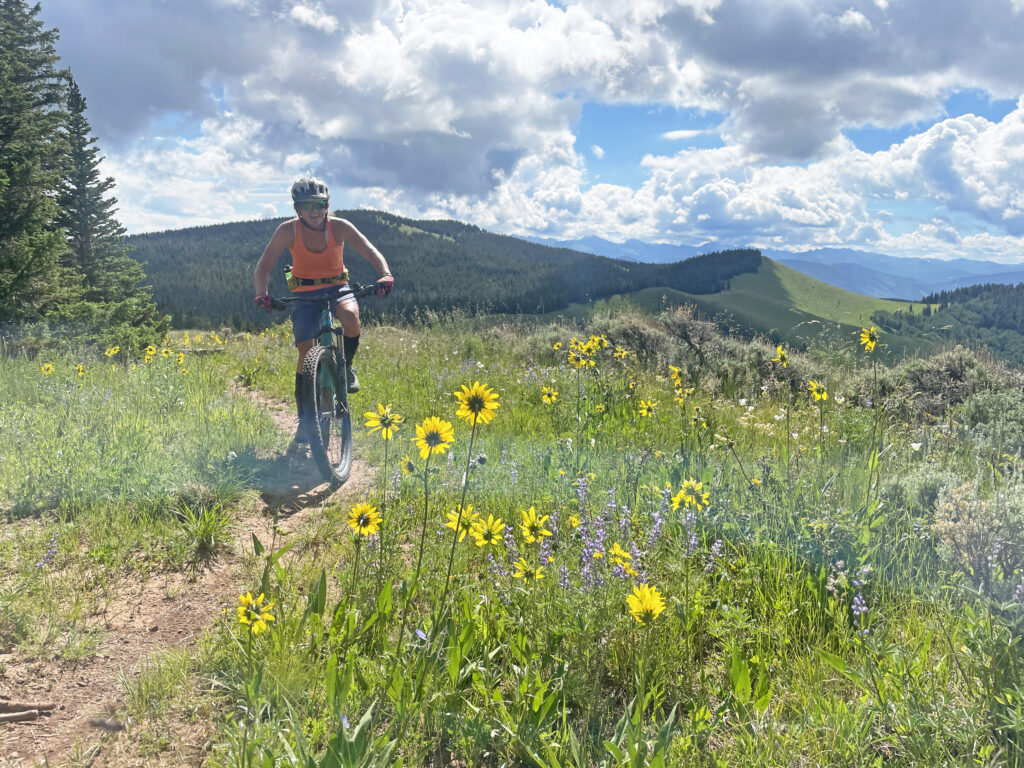Read the article in the Vail Daily Here: https://www.vaildaily.com/news/saeger-trails-for-all-trails-forever/
Trails for All, Trails Forever: Trails Create a Healthy & Happy Community
by Ernest Saeger, Executive Director
Imagine you are on your favorite trail on a beautiful summer Colorado day. Your attention is focused on the mountain views, the sun shining on tall aspens, the softness of the dirt under your feet or on your bike tire, and the sound of birds singing. You are completely absorbed and present on a trail and with nature. You do not want to be anywhere else in the world except for right there and now. You completely forget about all your worries and the busy world we live in, not thinking about these things for a second.
The trail has taken you to your flow state. Simply imagining yourself on the trail and in nature more than likely makes you happier. Are you smiling right now?
Trails have many benefits for our community including economic, transportation, livability, conservation, and environmental. But the most impactful benefit that trails provide to us may be for our health, both physical and mental.
Trails connect us to nature. Spending time in nature is linked to many positive mental health outcomes including improved focus, lower stress, better mood, and a reduced risk of developing a mental health condition (American Psychological Association, Vol. 51, No. 3, 2020). Furthermore, research evidence shows that contact with nature is associated with increases in happiness, subjective well-being, positive affect, positive social interactions and a sense of meaning and purpose in life, as well as decreases in mental distress (Science Advances, Vol. 5, No. 7, 2019)
The same benefits and even more apply to youth in the outdoors. Youth who lived in neighborhoods with more access to trails and green space had a reduced risk of many psychiatric disorders later in life, including depression, mood disorders, schizophrenia, eating disorders and substance use disorder. For those with the lowest levels of green space exposure during childhood, the risk of developing mental illness was 55% higher than for those who grew up with abundant green space (PNAS, Vol. 116, No. 11, 2019).
Connection is one of the greatest benefits you get from trails and nature. This benefit is linked to a better connection to self, community, and purpose. Time in nature benefits personal growth, self-esteem, emotional regulation, and social skills (IJW, Vol 5, No. 4, 2015).
So how much do you need to get outside on the trails to benefit? According to a 2019 study, at least 120 minutes per week (Scientific Reports, Sci Rep 9, 7730, 2019) The best part is you can choose how you spend your time on a trail connecting with nature. It can be a mountain bike ride, hike or walk, trail run, or however you enjoy the trail. The 120 minutes does not even have to be at one time and can be broken up throughout the week. Or if you’re a weekend warrior, get out there for an hour on the trail each day. The more time you spend outside on the trail the better, but benefits do seem to peak at three to five hours per week. Sorry to break the news to you 24 hour or multi-day racers!
May is Mental Health Month. We encourage you to get outside on our trails for at least 120 hours per week. Don’t know where or how to get outside? Consider participating in our Soul Dirt program. Soul Dirt, created in partnership with Vail Health’s Behavioral Health, is the VVMTA’s newest program. Soul Dirt is designed to invite people outside and create access to outdoor opportunities so that everyone can experience the transformative power of the mountains in our backyard.
The VVMTA provides numerous opportunities to build a healthier community. Join us on the trail and connect with others in our community, whether it be on a bike, hike, or with a tool on trail crew. No matter who you do it with or how you do it, just get outside on a trail and connect with nature.
The VVMTA’s mission is to connect our community to the outdoors through sustainable recreation. The VVMTA advocates for soft surface trails, manages trail stewardship programs, maintains and builds trails, coordinates and trains volunteers, educates outdoor recreational users, and creates opportunities to access the outdoors. Through trail access and experiences, our community will improve its mental and physical health, quality of life, and economic vitality.
Works Cited
Colin, Capaldi A., and et al. “Flourishing in nature: A review of the benefits of connecting with nature andn its application as a wellbeing intervention.” International Journal of Wellbeing, vol. Vol 5, no. 4, 2015, p. 16. Mental Health America, https://mhanational.org/surroundings/outdoors-nature.
Kristine, Engemann, and Et Al. “Residential green space in childhood is associated with lower risk of psychiatric disorders from adolescence into adulthood.” PNAS, vol. Vol 116, no. No 11, 2019, p. 6. PNAS, https://www.pnas.org/doi/full/10.1073/pnas.1807504116.
Mathew, White P., and et al. “Spending at least 120 minutes a week in nature is associated with good health and wellbeing.” Scientific Reports, vol. Sci Rep 9, no. 7730, 2019, p. 11. Nature.com, https://www.nature.com/articles/s41598-019-44097-3#article-info.
University of Washington, and Gregory Bratman. “Nature and mental health: An ecosystem service perspective.” Science Advances, vol. Vol 5, no. 7, 2019, p. 14. Science Advances, https://www.science.org/doi/10.1126/sciadv.aax0903.
Weir, Kirsten. “Nurtured by nature.” American Psychological Association, vol. Vol. 51, No. 3, no. April 1, 2020, 2020, p. 50. American Psychological Association, https://www.apa.org/monitor/2020/04/nurtured-nature.

